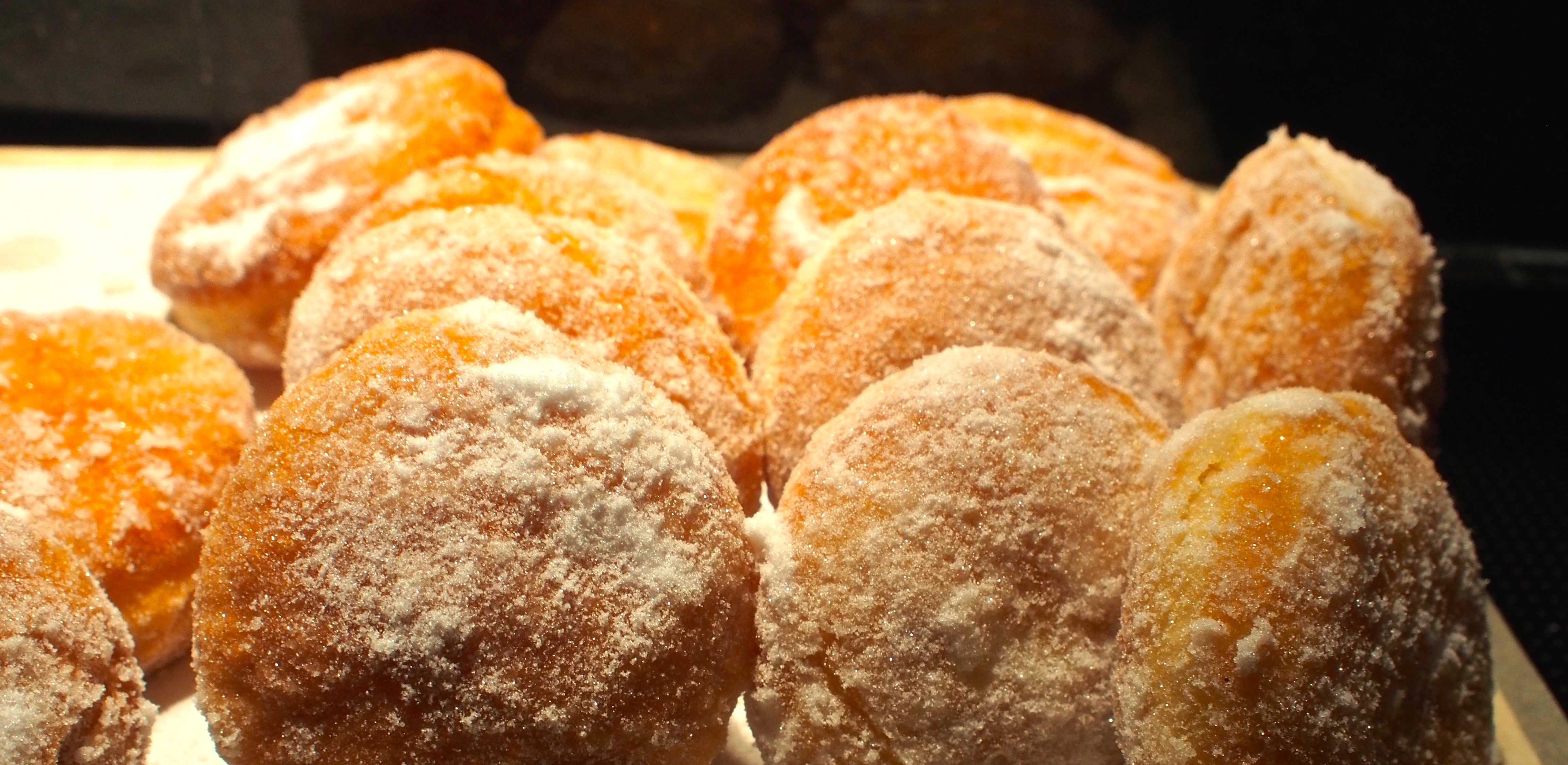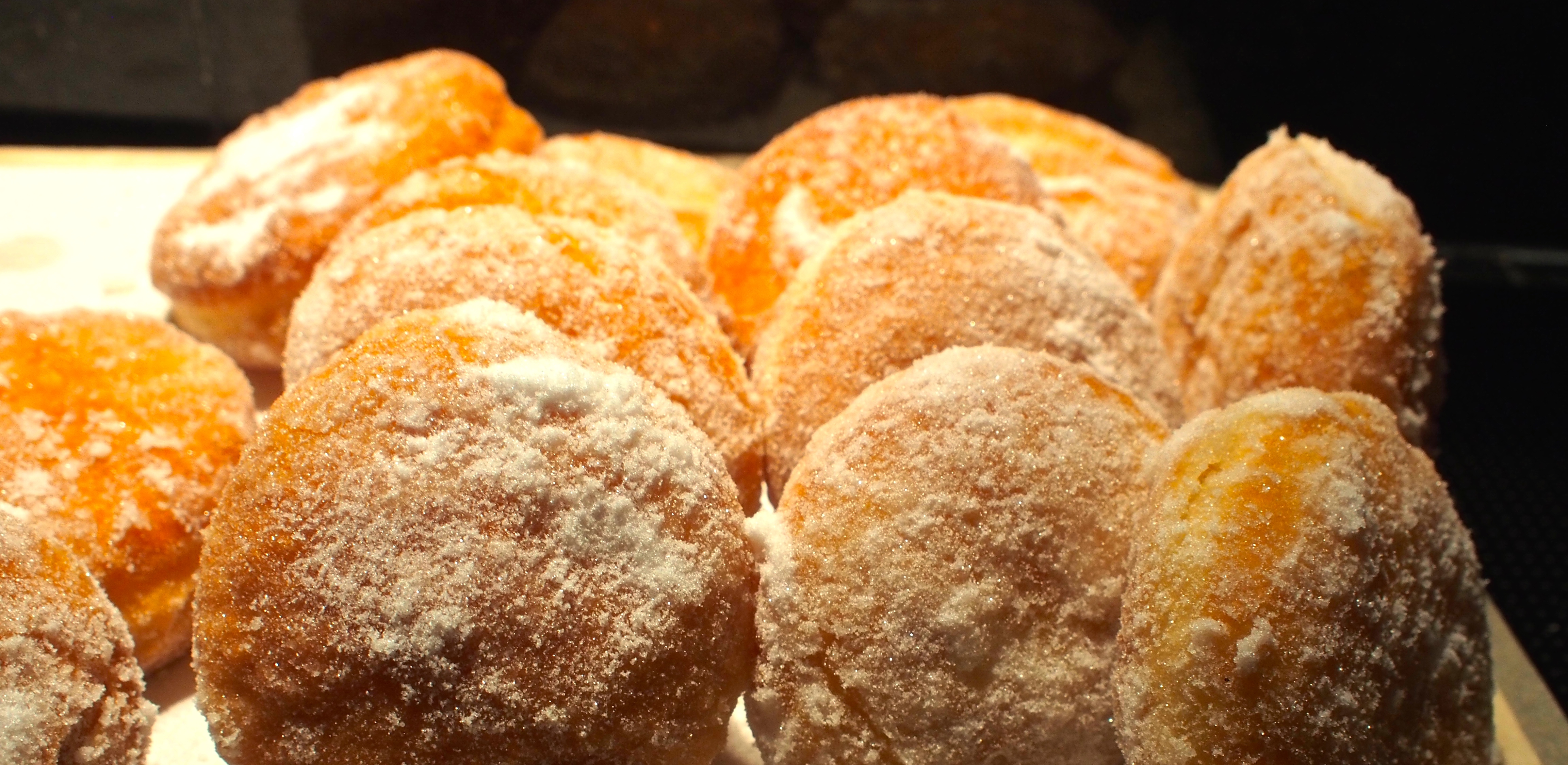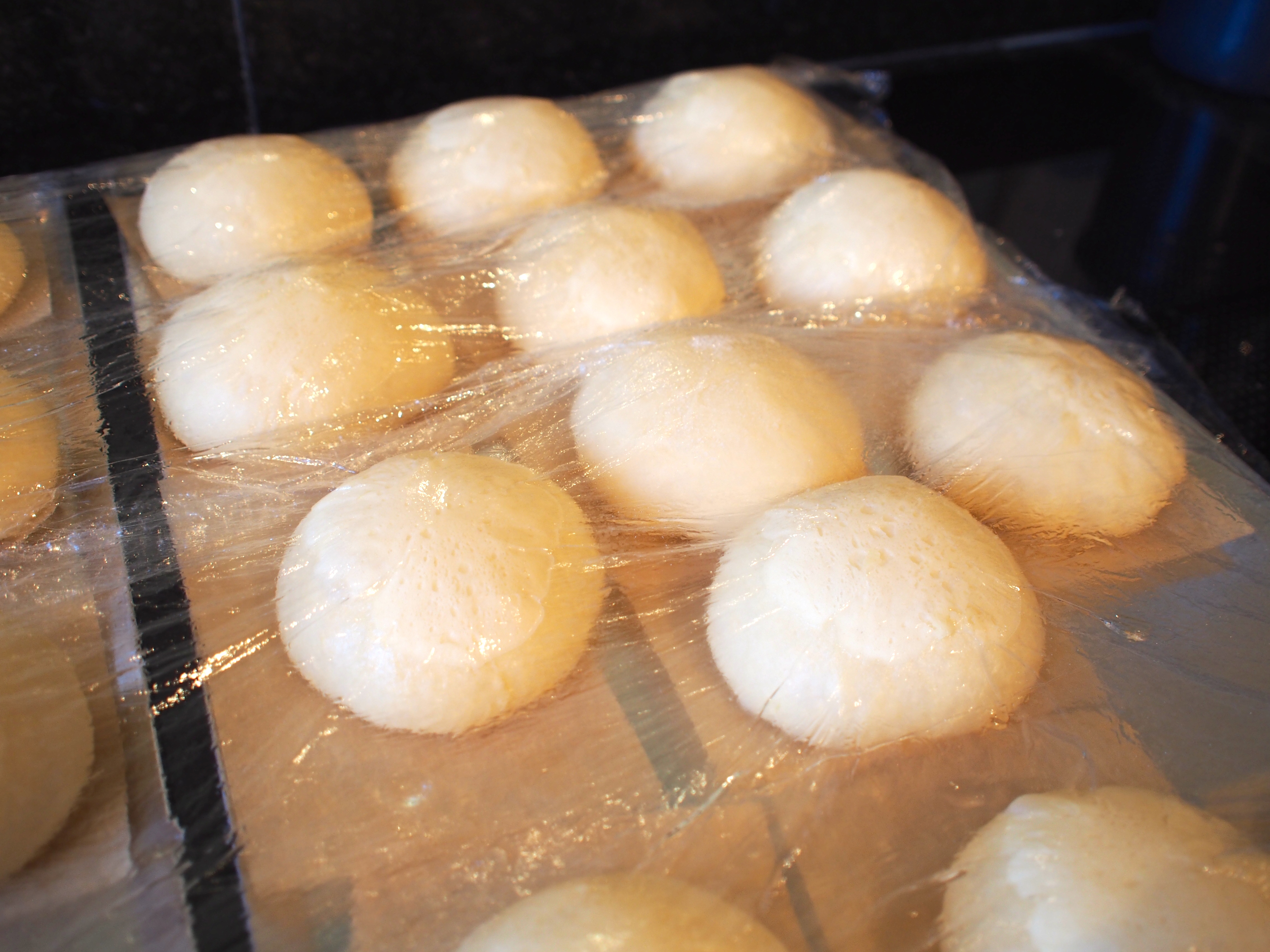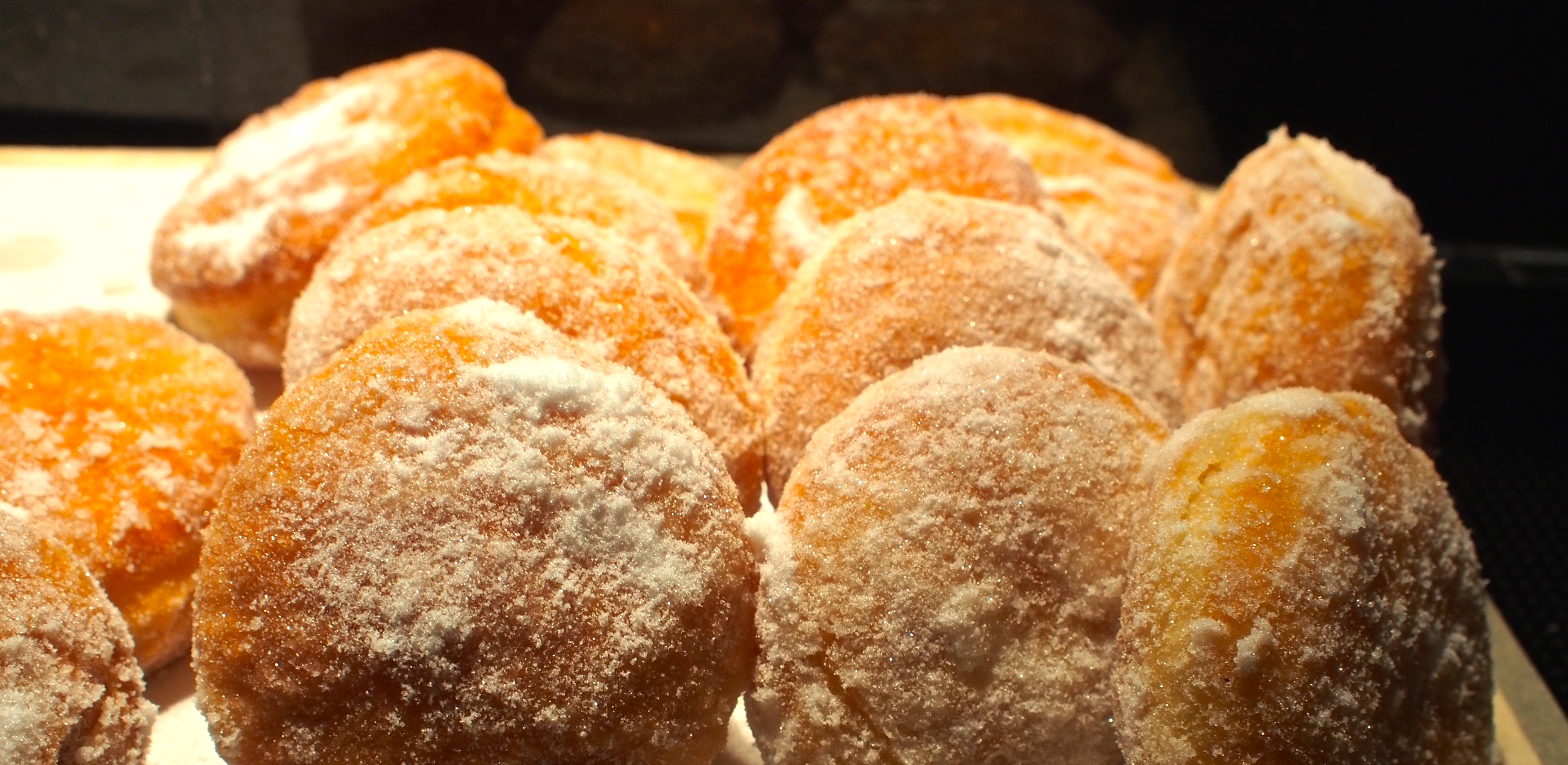 Amazingly, I’ve made doughnuts several times before and the results were very disappointing, and certainly not worth repeating. I knew I’d followed the instructions properly, so something else was going wrong. Hmmn. Maybe doughnuts weren’t for me.
Amazingly, I’ve made doughnuts several times before and the results were very disappointing, and certainly not worth repeating. I knew I’d followed the instructions properly, so something else was going wrong. Hmmn. Maybe doughnuts weren’t for me.
Well. You know me. I had to, didn’t I?
Before you begin, you might want to watch Justin in action…
Ready now? Let’s hop to it!
Makes 20, 45 minutes of prep, proving, overnight chilling, cooking time 4 minutes per doughnut
Ingredients
60g caster sugar
10g fine sea salt
15g fresh yeast, crumbled
4 eggs
Zest of ½ lemon
150g water
125g softened unsalted butter
To cook:
2 litres sunflower oil, for deep-frying
To toss:
Caster sugar
Method
- Put all the dough ingredients apart from the butter into the bowl of an electric mixer with a beater attachment and mix on a medium speed for eight minutes, or until the dough starts coming away from the sides and forms a ball.
- Turn off the mixer and let the dough rest for one minute. Take care that your mixer doesn’t overheat – it needs to rest as well as the dough.
- Start the mixer up again on a medium speed and slowly add the butter to the dough – about 25 grams at a time. Once it is all incorporated, mix on high speed for five minutes, until the dough is glossy, smooth and very elastic when pulled, then cover the bowl with clingfilm and leave to prove until it has doubled in size. Knock back the dough, then re-cover the bowl and put into the fridge to chill overnight.
- The next day, take the dough out of the fridge and cut it into 50 gram pieces (you should get about 20). Roll them into smooth, taut, tight buns and place them on a floured baking tray, leaving plenty of room between them as you don’t want them to stick together while they prove. Cover lightly with clingfilm and leave for about four hours, or until about doubled in size.
- Get your deep-fat fryer ready, or get a heavy-based saucepan and fill it up to the halfway point with rapeseed oil (please be extremely careful, as hot oil is very dangerous). Heat the oil to 180°C.
- When the oil is heated to the correct temperature, carefully remove the doughnuts from the tray by sliding a floured pastry scraper underneath them, taking care not to deflate them, and put them into the oil. Do not overcrowd the fryer – do two to three per batch, depending on the size of your pan.
- Fry for two minutes on each side until golden brown – they puff up and float, so you may need to gently push them down after about a minute to help them colour evenly. Remove from the fryer and place on kitchen paper, then toss them in a bowl of caster sugar while still warm. Repeat until all are fried, BUT make sure the oil temperature is correct every time before you fry – if it is too high they will colour too quickly and burn, and will be raw in the middle, and if it is too low the oil will be absorbed into the doughnut and it will become greasy. Set aside to cool before filling.
- To fill the doughnuts, make a hole in the crease of each one (anywhere around the white line between the fried top and bottom). Fill a piping bag with your desired filling and pipe into the doughnut until swollen with pride. Roughly 20 to 50g is the optimum quantity, depending on the filling; cream will be less, because it is more aerated.
- You can fit in more than this, but it doesn’t give such a good balance of dough to filling. The doughnuts are best eaten straight away, but will keep in an airtight tin and can be reheated to refresh them.
- The dough will seem very wet and sticky in the first stage. It did make it difficult to handle when it came to rolling out, but based on the end results, I’m assuming this is the way it should be
- When it came to frying, I tried something called Crisco, which is a non-trans fat vegetable shortening. I know Justin uses rapeseed oil for his, though the recipe refers to sunflower oil. Both have a higher smoking point than Crisco, which can only go as high as the 180ºC temperature the recipe calls for. Crisco is apparently absorbed less by the product you’re frying, and this certainly seemed to be the case. However, unless you can give the process 150% of your attention at all times, you might want to use oil.. Either way, keep the thermometer in the pan the whole time to ensure you’re not overheating the oil!
- On Tom’s show, Tom put his doughnuts onto little squares of grease-proof paper, and put the whole thing into the fryer – this does work incredibly well, and allows you to maintain the lightness in the doughnut, and not to be too rough. He suggests removing the paper when you flip the doughnut, but in mine, it left a blonde spot in the centre of the doughnut. I teased the paper away after one minute, and that worked well
- Do dust them in sugar immediately, the sugar gets a bit clumpy if you leave it, even just for a minute or so
- Make sure you have two pairs of tongs for the process – I popped the doughnuts in using a Chinese spider, used one pair whilst they were in the pan, but another pair when they were in the sugar. If you drop sugar into your oil, it will caramelise, and sit on the bottom of the pan,. There’s a danger of having that burnt sugar stick to your pristine golden loveliness if you’re not paying attention… Trust me – just use two pairs…
- I didn’t use Justin’s fillings, but only because they were quite time-consuming, quite rich. Instead, I made a batch of my thermomix creme patisserie (minus the vanilla), and divided it into three. I then mixed the custard with lemon curd, with salted caramel, and with fresh raspberries. To be honest, they’re so good, you could put anything you like in them.
- Hubby was so intrigued by these he popped to Borough Market to get some actual JG doughnuts to try… I found the caramel too rich, and didn’t like the burnt edge to the honeycomb, but the vanilla one was divine even a day later!
For the custard and salted honeycomb sprinkle filling:
250g caster sugar, plus 2 tbsp
500ml full fat milk
8 egg yolks
30g soft light brown sugar
30g soft dark brown sugar
90g plain flour
200ml double cream
Honeycomb
Maldon sea salt
Method:
- Put the 250 grams of caster sugar into a heavy-based saucepan and let it dissolve slowly, then on a medium heat turn it into a dark brown caramel (don’t go too far, or it will burn and become too bitter; it should take approximately 20 to 30 minutes). Once the right colour is reached, stop the caramel going any further by taking the pan off the heat and adding the milk (watch out, as it will spit and boil once the milk is added). Then return it to a low heat and melt the caramel into the milk.
- Meanwhile put the egg yolks and brown sugars into a bowl and mix together for a few seconds, then sift in the flour and mix again.
- Bring the milk just to the boil and pour over the yolk mixture, whisking constantly to prevent curdling, then return the mixture to the pan. Cook over a medium heat, whisking constantly for about four to five minutes, until very thick.
- Pass through a fine sieve and place a sheet of clingfilm on the surface of the custard to prevent a skin forming. Leave to cool, then refrigerate.
- Whip the cream and the two tablespoons of caster sugar together until thick but not over-whipped and fold into the chilled custard.
- Bash up the honeycomb with a good pinch of Maldon sea salt, using the end of a rolling pin, and sprinkle on top of your filled doughnuts.
500ml full fat milk
6 egg yolks
125g caster sugar, plus an extra 2 tablespoons
80g plain flour
200ml double cream
Method:
- Slit the vanilla pod open lengthways and scrape out the seeds. Put both pod and seeds into a heavy-based saucepan with the milk and bring slowly just to the boil, to infuse the vanilla.
- Meanwhile place the egg yolks and the 125 grams of sugar in a bowl and mix together for a few seconds, then sift in the flour and mix again.
- Pour the just-boiling milk over the yolk mixture, whisking constantly to prevent curdling, then return the mixture to the saucepan. Cook over a medium heat, whisking constantly for about five minutes, until very thick.
- Pass through a fine sieve, discarding the vanilla, and place a sheet of clingfilm on the surface of the custard to prevent a skin forming.
- Leave to cool, then refrigerate.
- Whip the cream and the two tablespoons of sugar together until thick but not over-whipped and fold into the chilled custard.
For the Seville orange custard with ginger snap sprinkle filling
1 vanilla pod
500ml full fat milk
6 egg yolks
125g caster sugar, plus 2 tbsp
80g plain flour
200ml double cream
Ginger snaps
Method:
- Zest and juice the oranges, then split the vanilla pod open lengthways and scrape out the seeds. Put the zest, seeds and pod into a heavybased saucepan with the milk and bring slowly to the boil, to infuse with the zest and the vanilla. Set the orange juice aside to add later. Meanwhile place the egg yolks and the 125 grams of caster sugar in a bowl and mix together for a few seconds, then sift in the flour and mix again.
- Pour the just-boiling milk over the yolk mixture, whisking constantly to prevent curdling, then return the mixture to the saucepan. Cook over a medium heat, whisking constantly for about five minutes, until very thick, then gradually whisk in the orange juice.
- Pass through a fine sieve and place a sheet of clingfilm on the surface of the custard to prevent a skin from forming. Discard the orange zest and vanilla pod. Leave to cool, then refrigerate.
- Whip the cream and the two tablespoons of caster sugar together until thick but not over-whipped and fold into the chilled custard. Break up the ginger snaps and sprinkle on top of your filled doughnuts.


